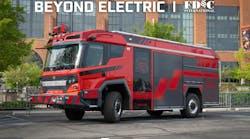Drill 1: Hide and Seek (also known as, “We were drilling, Chief…really!”)
For this drill, lying in bed during the day actually is an element of TI practice. One member is “it” and goes into the bunkroom. Inside, he briefly lies on top of several bunks to transfer heat to several beds, then stuffs some pillows under the blankets of a few others. The overall goal is to create several heat signatures as well as some lumps that could be interpreted as a person. Then, the member hides under the blanket of a bunk. With the lights off and the shades down in the bunkroom, a member enters with the TI and tries to find the hiding member as quickly as possible. Time the search effort to give that person a score, then it’s his turn to hide. He creates the same kind of heat signature distractions and false people before hiding himself. Work each member through the drill and see who is able to find the hiding person the fastest.
After the drill, review what types of heat signatures were confusing or easy to interpret. Remind members how blankets and comforters hide body heat, especially with small children. Reiterate the importance of searching all beds, top to bottom, by hand. One tip on bed searches: pull the bed away from the wall. This ensures that a child has not wedged himself or herself between the wall, mattress and frame, just out of reach of a good sweep.
Drill 2: Carrying and Using
If the imager doesn’t come off the rig, it cannot assist your firefighters. Have a member gear up and sit in the seat assigned to the thermal imager. Have him secure his coat and don his self-contained breathing apparatus (SCBA). Time him as he secures the TI using your department’s carrying system, then exits the rig and deploys an additional tool, such as the irons or a pre-connect line (photo 1). In companies that are slower and could use some practice or that have several newer members, consider combining this with a bunker/pack drill. Start timing them before they gear up, allowing them to practice putting all of the motions together: bunkering up, packing up, grabbing the imager and getting a tool.
This is an easy drill, but it builds the habit of grabbing the TI whenever firefighters bunker up. By reinforcing the policy of taking the imager even in this simple drill, you increase the likelihood that members will automatically take the imager at emergency incidents. When the imager is returned to its storage position, ensure that members engage the battery charging system and verify it is functioning properly. They should also ensure that the imager is properly secured in storage.
Also, verify that all members can easily and quickly change the battery. Practice changing the battery with and without firefighter gloves on, as well as with your eyes closed. Most imagers have physical indicators (such as notches in certain locations or special shapes) to help firefighters orient and install batteries in zero visibility. Verify members can identify these indicators by name as well as in practice.
Drill 3: Building Evaluation
This drill is designed to improve members’ image interpretation and size-up capabilities with the imager. This can also be done at the firehouse or while out testing hydrants or buying groceries. Have members use the TI to examine several buildings (photos 2A and 2B). Discuss how the building construction may be evident on the TI. Discuss why various buildings show certain heat signatures. Ensure all members keep in mind the effects of the sun, especially during the day or shortly after sunset. Discuss how rain, snow or building construction could be hiding heat from your imager. Try to determine why certain items appear hotter than others on the building.
Conclusion
While training in fire environments is important in your TI education, few fire departments get extensive time in practice burns. These “firehouse drill” tips, which don’t require a burn tower, should help firefighters get more opportunities to improve their image interpretation skills (photo 3).
Jonathan Bastian is the thermal imaging training manager at Bullard. He leads the training team, whose primary effort is to educate the fire service on the safe and proper use of thermal imagers. Bastian is certified as a thermal imaging instructor by the Law Enforcement Thermographers’ Association (LETA), the international public safety organization specializing in thermal imager certification and training. He is also a member of the NFPA Technical Committee on Fire Service Training. Educated at Brown University and licensed as a high school teacher in Illinois, Bastian served 12 years on the North Park, IL, Fire Department, including the last three as a captain. As health and safety officer, he led the development and implementation of the department’s rapid intervention team SOG. Bastian is a certified Fire Instructor I and Firefighter III, and he spent 12 years as an EMT-I/D. He has taught classes on thermal imaging, rapid intervention teams, and search and rescue operations. Bastian is happy to answer any questions about thermal imaging; contact him at [email protected].







